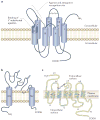Purinergic signalling in neuron-glia interactions
- PMID: 16715052
- PMCID: PMC2062484
- DOI: 10.1038/nrn1928
Purinergic signalling in neuron-glia interactions
Abstract
Activity-dependent release of ATP from synapses, axons and glia activates purinergic membrane receptors that modulate intracellular calcium and cyclic AMP. This enables glia to detect neural activity and communicate among other glial cells by releasing ATP through membrane channels and vesicles. Through purinergic signalling, impulse activity regulates glial proliferation, motility, survival, differentiation and myelination, and facilitates interactions between neurons, and vascular and immune system cells. Interactions among purinergic, growth factor and cytokine signalling regulate synaptic strength, development and responses to injury. We review the involvement of ATP and adenosine receptors in neuron-glia signalling, including the release and hydrolysis of ATP, how the receptors signal, the pharmacological tools used to study them, and their functional significance.
Figures




References
-
- McCarthy KD, Salm AK. Pharmacologically-distinct subsets of astroglia can be indentified by their calcium response to neuroligands. Neuroscience. 1991;41:325–333. - PubMed
-
- Burnstock G. In: Current Topics in Membranes. Schwiebert EM, editor. Vol. 54. Academic; San Diego: 2003. pp. 307–368.
Publication types
MeSH terms
Substances
Grants and funding
LinkOut - more resources
Full Text Sources

